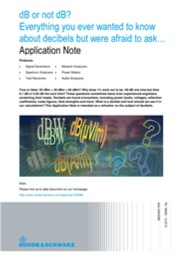dB or not dB?
True or false: 30 dBm + 30 dBm = 60 dBm? Why does 1% work out to be -40 dB one time but then 0.1 dB or 0.05 dB the next time? These questions sometimes leave even experienced engineers scratching their heads. Decibels are found everywhere, including power levels, voltages, reflection coefficients, noise figures, field strengths and more. What is a decibel and how should we use it in our calculations? This Application Note is intended as a refresher on the subject of decibels.
Read More
By submitting this form you agree to Rohde & Schwarz contacting you with marketing-related emails or by telephone. You may unsubscribe at any time. Rohde & Schwarz web sites and communications are subject to their Privacy Notice.
By requesting this resource you agree to our terms of use. All data is protected by our Privacy Notice. If you have any further questions please email dataprotection@techpublishhub.com
Related Categories: ATEX equipment and design, Automated test equipment, Batteries, Boundary scan equipment, Capacitors, Cellular, Communication, Components, Connectors, cooling, Development and debug tools, Digital/software-defined power, Distributed power, Edge computing, Electronic safety systems, Embedded, Embedded operating systems and software, Energy harvesting, Evaluation boards, Field-test equipment, IIoT, Inductors, Industrial, Industrial networking, Industry 4.0 technology, Laboratory/bench equipment, LDOs, LPWAN technologies, Magnetics and wound components, Microcontrollers, Motor control, Near-Field Communication (NFC), PCB-substrate technology, PLCs and industrial computers, Power, Power modules, Power semiconductors, Power supplies and converters/inverters, Protection Devices, Resistors, SBCs and modules, Sensing and automation, SMD passives, Sub-GHz/ISM-band radio, Switched-mode converters, Switches, Test & Measurement, Test probes and pins, Test software, Transformers, Wireless networking ICs and modules, Wireless testing


